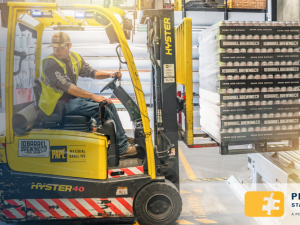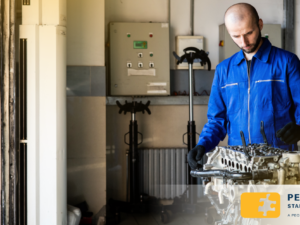
Most people think mentorship takes years—but meaningful career growth can start with just a few focused conversations. Across industries like light industrial and administrative work, there’s growing power in something smaller: micro-mentorships. Consider this example:
When Luis started his first shift as a warehouse associate, he was overwhelmed by the pace. But when Carla, a 10-year veteran, pulled him aside and showed him how to organize his pick cart efficiently, everything clicked. That 15-minute conversation didn’t just help him do the job—it set the tone for his confidence going forward.
These short, focused mentoring moments are changing how people learn, lead, and grow on the job. Whether you’re operating a machine, managing inventory, or handling scheduling at the front desk, micro-mentorships can help you—or someone on your team—gain confidence and skills that carry long-term value.
Here’s another example:
A front desk assistant might teach a new coworker the best way to prioritize urgent calls during shift changes—sharing not just the steps, but the logic and judgment behind those decisions. That quick exchange becomes a micro-mentorship, offering both instruction and insight.
What Is a Micro-Mentorship?
A micro-mentorship is a brief, intentional connection between a more experienced worker and someone learning something new. It might last an hour, a day, or a week—just long enough to build confidence around a specific task, process, or decision.
At first glance, micro mentorships might sound like standard training or simply getting help from a coworker—but they’re something more intentional. What sets micro-mentorships apart is their focus on context, reasoning, and growth—not just task completion.
- Not just training: Traditional training is typically structured, one-way, and focused on task execution. Micro mentorships, on the other hand, are two-way interactions that emphasize guidance, growth, and shared knowledge—not just instructions.
- More than a quick tip: While a coworker might show you how to clock in or run a machine, a micro mentorship moment goes deeper. It includes more background, added context, and a clear explanation of why something is done a certain way. It might also offer an alternative method and the reasoning behind it—helping the employee understand not just how, but why and when to apply a process or approach.
Unlike traditional mentorships, which often require formal programs and long-term commitment, micro-mentorships are simple, flexible, and naturally woven into the workday. Think of them as “on-the-spot” career boosts.
And micro-mentorships are just one part of a growing shift in how we think about mentoring at work. New models like peer mentoring, reverse mentoring, and moment-based coaching are redefining what effective mentorship looks like.
Why Micro-Mentorships Work So Well in Light Industrial and Admin Roles
Let’s face it: in fast-paced environments like warehouses, production lines, or busy offices, there isn’t always time for structured mentorship. But there is time to show someone how to complete a job safely, efficiently, and with pride.
Micro-mentorships are a natural fit for these workspaces:
- They match the pace of the work. Quick, focused learning keeps things moving.
- They feel practical. Real-world guidance from someone who’s done the job before is often more valuable than classroom instruction.
- They build team culture. When experienced workers take a moment to support others, it boosts morale across the board.
How Micro-Mentorships Help Workers Grow
Even if you’re not looking to become a manager right now, micro-mentorships can be a big step toward leadership. When you teach others, you strengthen your own skills, too. And if you’re the one learning, those short coaching moments can help you:
- Master a new machine – not just run it, but understand it.
- Understand safety protocols more clearly.
- Improve communication with your team.
- Explore new paths, like shift lead or quality control.
Whether you work in a warehouse, on a production line, or in an office support role, these brief learning experiences help you grow more confident and capable in your role.
How Managers and Supervisors Can Use Micro-Mentorships
You don’t need a leadership title to be a mentor. But if you are a manager or supervisor, encouraging micro-mentorships can strengthen your entire team.
Here’s how:
- Pair new hires with experienced staff for their first few days.
- Encourage team members to ask each other for help and share tips.
- Celebrate when someone teaches someone else.
Micro-mentorships also help identify hidden leaders—people who may not speak up often but shine when given the chance to share what they know.
Getting Started: Easy Ways to Try It
Want to try a micro-mentorship yourself? Here are a few ideas:
- Show a newer teammate your time-saving trick for organizing tools.
- Offer to help someone learn a tricky part of their admin workflow.
- Ask your supervisor if you can shadow a task outside your normal routine.
Remember, micro-mentorships are all about intention. They don’t have to be big. They just have to make a difference.
It Only Takes a Moment to Make a Difference
In busy workplaces, it’s easy to feel like you don’t have time to grow your career—or help someone else grow theirs. But micro-mentorships prove otherwise. A few minutes. A helpful tip. A shared experience.
That’s all it takes to open new doors, build confidence, and spark the kind of pride that makes work more than just a job.
At Peoplelink Staffing, we believe great teams grow through shared experience—not just resumes. That’s why we don’t just place workers—we help create the kind of strong, supportive teams where mentorship, growth, and confidence thrive. Let us help you build your best team.





